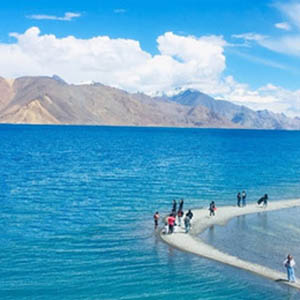How to Acclimatize for Leh Ladakh Trip
![]()
Acclimatization is one of the important things to prepare for while planning a trip to Ladakh. Leh and most of the places in Ladakh are located above the altitude of 10,000 feet. Thus, visitors may suffer from dizziness, headaches or even acute mountain sickness (AMS). So acclimatization to the high altitude condition becomes one of the most important things to prepare for before planning a trip.
The best thing about going to Ladakh, nestled amidst the Himalayas and The Karakoram ranges, is savoring the breathtaking views. But there are some issues which travelers to such high-altitude face. They complain of vomiting, dizziness, less amount of oxygen, etc. These problems do not allow them to enjoy to the fullest. Some people can deal with them easily while others really suffer because of them.
Sickness during Ladakh trip is pretty common if one flies or drives to such a higher altitude directly. One has to experience quite extreme consequences. With the increase in altitude, things can get more serious. Therefore, before you set your foot out of your house to go to Ladakh, you should be aware of what altitude sickness is and how to save yourself from it.
Causes of AMS
The scarcity of oxygen at a great height is the major cause of Acute Mountain Sickness in Ladakh. Decreased air pressure and lower less oxygen content are quite common at higher altitude. When you scale such heights, your body may not get enough time to adapt to the changing surroundings. This is what leads to acute mountain sickness. Besides this, the level of exertion you undergo also plays an important role. Activities which demand great physical efforts like trekking, hiking, mountaineering contribute towards causing AMS at great heights.
Symptoms of AMS
The symptoms of Acute Mountain Sickness in Ladakh may resemble to that of the carbon monoxide poisoning, flu or a hangover. Fatigue, headache, stomach disorders, sleep disturbance, nausea and dizziness are other common symptoms of AMS.
Depending from person to person, the symptoms may also vary. Some may experience mild symptoms like a headache with swelling of feet, hands and face. While others may have nose bleeding accompanied by headache.
Usually, these symptoms may last for the short term, say, two days or a week. But, a few of them may indicate life-threatening AMS. The symptoms which indicate such a situation are related to cerebral edema and pulmonary edema.
Medicine to take or carry
Diamox – Diamox helps the body to breathe faster hence accelerating the acclimatization process. Take it as preventive medicine and not once you start feeling AMS.
- Suggested Quantity – 125-250 mg twice a day
- Side Effects – tingling in toes and fingers, numbness, vomiting, nausea, frequent urination etc.
Aspirin/Disprin – Aspirin and Disprin work as blood thinners and enable your blood to carry more oxygen.
Dexamethasone – Dexamethasone also helps in overcoming AMS.
- Suggested Quantity – 2-4 mg after every 6 hours
Oxygen Cylinders – One must carry portable oxygen cylinders easily available at the chemist shop to avoid AMS.
Note – These medicines are only a recommendation. Do consult an experienced doctor before taking them. If the symptoms still persist, it’s better to drop the idea of moving further. One should immediately plan to descend to a lower altitude.
Apart from these allopathic medicines, natural remedies like Clove, Garlic and Ginger can be used to alleviate AMS.
Hospitals in case of AMS
Acute Mountain Sickness can hit anybody at higher altitude. Thus, it becomes really necessary to keep a note of nearby hospitals and dispensaries. The Sonum Norbu Memorial Hospital in Leh and Medical Dispensaries at Mulbek, Drass, Sankoo, Trespone, Padum and Panikhar can be sought after in case of AMS.
How to avoid AMS?
The best way to avoid the increased risk of AMS is to acclimatize. In order to do so, travelers must follow all the necessary precautions while they travel to Ladakh. If you arrive to Leh by air, keep a day free to simply acclimatize. Proper rest must be taken every day. Enough sleep, good food and no exertion will help your body get used to the heights, and low oxygen. If you are planning a road trip to Ladakh, do not over exert yourself. The key is to provide enough rest your body. Gradually, let it adjust to the heights and low oxygen levels.
Precautions to take to overcome AMS
As it is said, ‘Prevention is better than cure’. So one must follow certain preventive steps to fight with AMS. Here’s what you can do!
- Get a complete physical check up to make sure you have no serious health issues.
- If you have a blood pressure problem, do consult your doctor before planning the trip.
- Rest properly for at least 48 hours.
- Review the symptoms of mountain sickness so you can recognize and treat them quickly.
- Maintain proper hydration levels in your body. Drink water frequently. You can also mix it with electrolytes and glucose for the extra energy.
- Avoid over-exertion.
- Ascend slowly.
- Avoid anti-depressants and alcohol.
- Stay at bay from overeating.
- Do not spend too much time at high altitude pass.
Sensitive Areas for AMS
Although AMS can hit anybody anywhere, but there are some areas where the high chances of suffering from AMS are high.
- Changthang, at an altitude of 14,846 ft above sea level
- Tanglang La, elevation 5,328 metres (17,480 ft),
- Pangong Tso, 4,350 m (14,270 ft).
- Tso Moriri, at an altitude of 4,522 m (14,836 ft).
Acclimatization is the key when planning a tour to Ladakh. Plan your Ladakh tour properly and keep AMS at bay!















